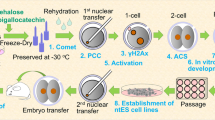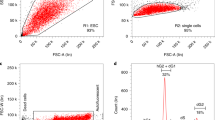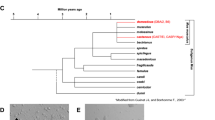Abstract
A great deal of time and energy goes into the creation of each new line of transgenic mice; established lines are expensive and labor-intensive to maintain. Archiving of mice by cryopreservation of germ cells or embryos represents a means to free up facility space, while protecting the line from loss due to environmental disasters, genetic drift, or infectious disease. The author reviews the available cryopreservation techniques and presents considerations for setting up a cryopreservation facility.
This is a preview of subscription content, access via your institution
Access options
Subscribe to this journal
We are sorry, but there is no personal subscription option available for your country.
Buy this article
- Purchase on Springer Link
- Instant access to full article PDF
Prices may be subject to local taxes which are calculated during checkout

Similar content being viewed by others
References
Mobraaten, L.E. Mouse embryo cryobanking. J. In Vitro Fert. Embryo Transf. 3(1), 28–32 (1986).
Mobraaten, L. Cryopreservation in a transgenic program. Lab Anim. (NY) 28(Suppl 1), 15–18 (1999).
Glenister, P.H. & Thornton, C.E. Cryoconservation—archiving for the future. Mamm. Genome 11(7), 565–571 (2000).
Critser, J.K. & Mobraaten, L.E. Cryopreservation of murine spermatozoa. ILAR J. 41(4), 197–206 (2000).
Marschall, S. & Hrabe de Angelis, M. Cryopreservation of mouse spermatozoa: double your mouse space. Trends Genet. 15(4), 128–131 (1999).
Whittingham, D.G., Leibo, S.P. & Mazur, P. Survival of mouse embryos frozen to −196 degrees and −269 degrees C. Science 178(59), 411–414 (1972).
Leibo, S.P. Personal communication. Dr. Leibo elaborates, “That remark was made to me by a very close friend [at the Basel Institute for Immunology], in about 1974 or 75.”
Culliton, B.J. Fire devastates Jackson lab. Science 244(4906), 767–768 (1989).
Sincell, M. Houston flood. Research toll is heavy in time and money. Science 293(5530), 589 (2001).
Nakagata, N. et al. Cryopreservation of spermatozoa of a transgenic mouse. [Japanese] Jikken Dobutsu 41(4), 537–540 (1992).
Nakagata, N. & Takeshima, T. Cryopreservation of mouse spermatozoa from inbred and F1 hybrid strains. Jikken Dobutsu 42(3), 317–320 (1993).
Nakagata, N. Studies on cryopreservation of embryos and gametes in mice. Exp. Anim. 44(1), 1–8 (1995).
Nakagata, N. Use of cryopreservation techniques of embryos and spermatozoa for production of transgenic (Tg) mice and for maintenance of Tg mouse lines. Lab. Anim. Sci. 46(2), 236–238 (1996).
Nakagata, N. Cryopreservation of mouse spermatozoa. Mamm. Genome 11(7), 572–576 (2000).
Sztein, J., Sweet, H., Farley, J. & Mobraaten, L. Cryopreservation and orthotopic transplantation of mouse ovaries: new approach in gamete banking. Biol. Reprod. 58(4), 1071–1074 (1998).
Migishima, F. et al. Successful cryopreservation of mouse ovaries by vitrification. Biol. Reprod. 68(3), 881–887 (2003).
Nakao, K., Nakagata, N. & Katsuki, M. Simple and efficient vitrification procedure for cryopreservation of mouse embryos. Exp. Anim. 46(3), 231–234 (1997).
Chen, S.U. et al. Vitrification of mouse oocytes using closed pulled straws (CPS) achieves a high survival and preserves good patterns of meiotic spindles, compared with conventional straws, open pulled straws (OPS) and grids. Hum. Reprod. 16(11), 2350–2356 (2001).
Park, S.E. et al. Cryopreservation of ICR mouse oocytes: improved post-thawed preimplantation development after vitrification using Taxol, a cytoskeleton stabilizer. Fertil. Steril. 75(6), 1177– 1184 (2001).
Lane, M. & Gardner, D.K. Vitrification of mouse oocytes using a nylon loop. Mol. Reprod. Dev. 58(3), 342–347 (2001).
Avarbock, M.R., Brinster, C.J. & Brinster, R.L. Reconstitution of spermatogenesis from frozen spermatogonial stem cells. Nat. Med. 2(6), 693–696 (1996).
Rall, W.F. & Fahy, G.M. Ice-free cryopreservation of mouse embryos at −196 °C by vitrification. Nature 313(6003), 573–575 (1985).
Sztein, J.M., Farley, J.S. & Mobraaten, L.E. In vitro fertilization with cryopreserved inbred mouse sperm. Biol. Reprod. 63(6), 1774–1780 (2000).
Kimura, Y. & Yanagimachi, R. Intracytoplasmic sperm injection in the mouse. Biol. Reprod. 52(4), 709–720 (1995).
Lacham-Kaplan, O. & Trounson, A. Intracytoplasmic sperm injection in mice: increased fertilization and development to term after induction of the acrosome reaction. Hum. Reprod. 10(10), 2642–2649 (1995).
Yanagimachi, R. Intracytoplasmic sperm injection experiments using the mouse as a model. Hum. Reprod. 13(Suppl 1), 87–98 (1998).
Szczygiel, M.A., Kusakabe, H., Yanagimachi, R. & Whittingham, D.G. Intracytoplasmic sperm injection is more efficient than in vitro fertilization for generating mouse embryos from cryopreserved spermatozoa. Biol. Reprod. 67(4), 1278–1284 (2002).
Nakagata, N., Okamoto, M., Ueda, O. & Suzuki, H. Positive effect of partial zona-pellucida dissection on the in vitro fertilizing capacity of cryopreserved C57BL/6J transgenic mouse spermatozoa of low motility. Biol. Reprod. 57(5), 1050–1055 (1997).
Nagy, A., Gertsenstein, M., Vintersten, K. & Behringer, R. Manipulating the Mouse Embryo: A Laboratory Manual 3rd edn. (Cold Spring Harbor Laboratory Press, Cold Spring Harbor, NY, 2003).
Dufrain, R.J. in Basic Aspects of Freeze-Preservation of Mouse Strains (ed. Mühlbock, O.) 73–84 (Gustav Fischer, Stuttgart, 1976).
Mazur, P. in Basic Aspects of Freeze-Preservation of Mouse Strains (ed. Mühlbock, O.) 1–12 (Gustav Fischer, Stuttgart, 1976).
Hawkins, A.E. et al. Hepatitis B nucleotide sequence analysis: linking an outbreak of acute hepatitis B to contamination of a cryopreservation tank. J. Virol. Methods 60(1), 81–88 (1996).
Tedder, R.S. et al. Hepatitis B transmission from contaminated cryopreservation tank. Lancet 346(8968), 137–140 (1995).
Van Keuren, M.L. & Saunders, T.L. Rederivation of transgenic and gene-targeted mice by embryo transfer. Transgenic Res. 13(4), 363–371 (2004).
Suzuki, H., Yorozu, K., Watanabe, T., Nakura, M. & Adachi, J. Rederivation of mice by means of in vitro fertilization and embryo transfer. Exp. Anim. 45(1), 33–38 (1996).
Reetz, I.C., Wullenweber-Schmidt, M., Kraft, V. & Hedrich, H.J. Rederivation of inbred strains of mice by means of embryo transfer. Lab. Anim. Sci. 38(6), 696–701 (1988).
Carthew, P., Wood, M.J. & Kirby, C. Pathogenicity of mouse hepatitis virus for preimplantation mouse embryos. J. Reprod. Fertil. 73(1), 207–213 (1985).
Morrell, J.M. Techniques of embryo transfer and facility decontamination used to improve the health and welfare of transgenic mice. Lab. Anim. 33(3), 201–206 (1999).
Legge, M. Oocyte and zygote zona pellucida permeability to macromolecules. J. Exp. Zool. 271(2), 145–150 (1995).
Baillargeon, P., Fecteau, G., Pare, J., Lamothe, P. & Suave, R. Evaluation of the embryo transfer procedure proposed by the International Embryo Transfer Society as a method of controlling vertical transmission of Neospora caninum in cattle. J. Am. Vet. Med. Assoc. 218(11), 1803–1806 (2001).
Stringfellow, D.A. & Seidel, S.M. IETS Manual 3rd edn (International Embryo Transfer Society, Sazvoy, IL, 1998).
Leibo, S.P., DeMayo, F.J. & O'Malley, B. Production of transgenic mice from cryopreserved ova. Mol. Reprod. Dev. 30(4), 313–319 (1991).
Landa, V. & Slezinger, M.S. Production of transgenic mice from DNA-injected embryos cryopreserved by vitrification in microdrops. Folia Biol. (Praha) 38(1), 10–15 (1992).
Keskintepe, L. Agca, Y., Pacholczyk, G.A., Machnicka, A. & Critser, J.K. Use of cryopreserved pronuclear embryos for the production of transgenic mice. Biol. Reprod. 65(2), 407–411 (2001).
Bagis, H., Odaman, H., Sagirkaya, H. & Dinnyes, A. Production of transgenic mice from vitrified pronuclear-stage embryos. Mol. Reprod. Dev. 61(2), 173–179 (2002).
Mazur, P., Katkov, II, Katkova, N. & Critser, J.K. The enhancement of the ability of mouse sperm to survive freezing and thawing by the use of high concentrations of glycerol and the presence of an Escherichia coli membrane preparation (Oxyrase) to lower the oxygen concentration. Cryobiology 40(3), 187–209 (2000).
Koshimoto, C., Gamliel, E. & Mazur, P. Effect of osmolality and oxygen tension on the survival of mouse sperm frozen to various temperatures in various concentrations of glycerol and raffinose. Cryobiology 41(3), 204–231 (2000).
Koshimoto, C. & Mazur, P. The effect of the osmolality of sugar-containing media, the type of sugar, and the mass and molar concentration of sugar on the survival of frozen-thawed mouse sperm. Cryobiology 45(1), 80–90 (2002).
Koshimoto, C. & Mazur, P. Effects of warming rate, temperature, and antifreeze proteins on the survival of mouse spermatozoa frozen at an optimal rate Cryobiology 45(1), 49–59 (2002).
Bath, M.L. Simple and efficient in vitro fertilization with cryopreserved C57BL/6J mouse sperm. Biol. Reprod. 68(1), 19–23 (2003).
Author information
Authors and Affiliations
Corresponding author
Rights and permissions
About this article
Cite this article
Landel, C. Archiving mouse strains by cryopreservation. Lab Anim 34, 50–57 (2005). https://doi.org/10.1038/laban0405-50
Received:
Accepted:
Issue Date:
DOI: https://doi.org/10.1038/laban0405-50
This article is cited by
-
Post-thaw ATP supplementation enhances cryoprotective effect of iodixanol in rat spermatozoa
Reproductive Biology and Endocrinology (2016)
-
Re-establishment of a breeding colony of immunocompromised mice through revival of cryopreserved embryos
Lab Animal (2013)
-
Effect of IVF and laser zona dissection on DNA methylation pattern of mouse zygotes
Mammalian Genome (2009)
-
Guidelines for hurricane and disaster preparation for animal facilities
Lab Animal (2007)



